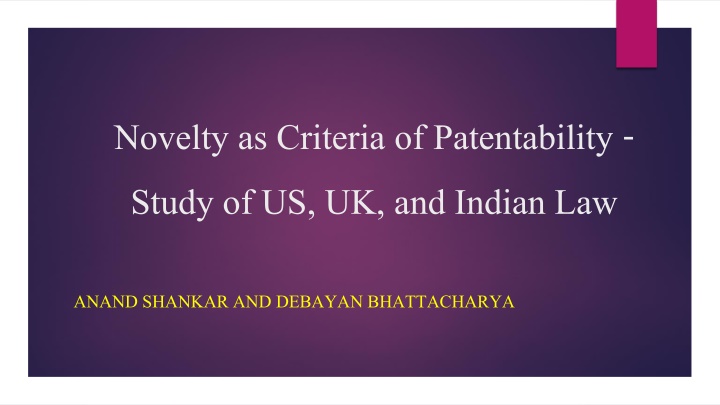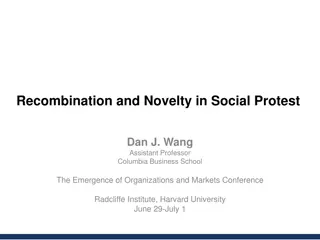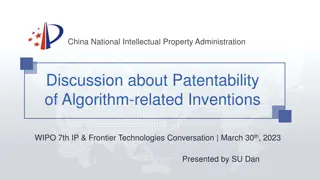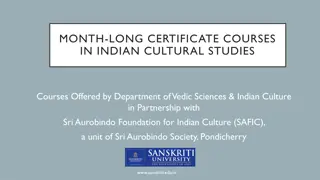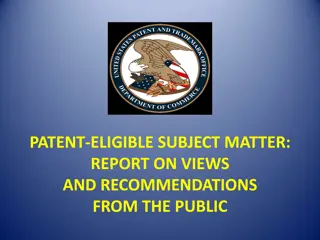Novelty as Criteria of Patentability: US, UK, and Indian Law Study
Embarking on the concept that only new inventions deserve patent protection, the study explores how novelty forms the foundation of intellectual property law, preventing patent proliferation and unfair competition. Delving into the specifics of Indian and United States laws, it analyzes the criteria for determining novelty and the process of assessing patent claims based on novelty standards.
Download Presentation

Please find below an Image/Link to download the presentation.
The content on the website is provided AS IS for your information and personal use only. It may not be sold, licensed, or shared on other websites without obtaining consent from the author.If you encounter any issues during the download, it is possible that the publisher has removed the file from their server.
You are allowed to download the files provided on this website for personal or commercial use, subject to the condition that they are used lawfully. All files are the property of their respective owners.
The content on the website is provided AS IS for your information and personal use only. It may not be sold, licensed, or shared on other websites without obtaining consent from the author.
E N D
Presentation Transcript
Novelty as Criteria of Patentability - Study of US, UK, and Indian Law ANAND SHANKAR AND DEBAYAN BHATTACHARYA
INTRODUCTION Embodies the core idea that only a novel invention should receive patent protection Forms the very basis of IP law Otherwise, may lead to proliferation of patents and unfair stifling of competition; undermine IP
INDIAN LAW Section 2(1)(l) of the 1970 Patents Act: new invention means any invention or technology which has not been anticipated by publication in any document or used in the country or elsewhere in the world before the date of filing of patent application with complete specification, i.e., the subject matter has not fallen in public domain or that it does not form part of the state of the art; It must be the inventor's own discovery as opposed to mere verification of what was, already known before the date of the patent. [Bishwanath Prasas Rradhe Shyam v. Hindustan Metal Industries] It should be something more than mere workshop improvement, and must independently satisfy the test of invention or inventive step. It must produce a new result, or a new article or better or cheaper article than before.
INDIAN LAW (CONT.) While this is hard to discern in practice, certain criteria may be used: First, the manner of manufacture must be known Second, it must not be an obvious/natural result of earlier knowledge Under the Test of Anticipation, it must be revealed by Prior publication Publicly known/used Under Section 25 of Patents Act, patent s granting can be opposed on the ground of a lack of novelty Under Section 64, a patent that is not novel can be revoked Expert evidence may be needed to determine whether an invention qualifies these criterion, since the knowledge is highly technical in nature
INDIAN LAW (CONT.) In law, there are four steps for a novelty claim: Prior use, art or knowledge and the inventive steps must be revealed The difference between these is to be clearly enumerated Due consideration to the actual difference objectively (needs experts) Degree of innovation, upon which decision is made The standard is that of an ordinary skilled person in the art
UNITED STATES LAW The USA has three criteria for a patent: Eligibility, Utility, and Novelty Of these, novelty is the most stringent Under 35 U.S.C. 102: The Doctrine of Anticipation This standard is very high: Each aspect of the patent should be novel and must not have been covered by any earlier patent If a skilled artisan could have taken the teachings and combined it with his own knowledge and come to such a conclusion, then the doctrine has not been met Contents of the test same as that of India: Prior publication anywhere in the world Publicly known in the USA
UNITED KINGDOM LAW Section 2 of the 1977 Patents Act Section 2(1): Invention is not part of the state of the art Section 2(2): All matter, (whether a product, a process, information about either, or anything else) which has at any time before the invention, been made available to the public (whether in the UK or elsewhere) by written or oral description, by use or in any other way. Section 2(3): Any pending invention filing Skilled persons may use their knowledge and determine whether what is covered is present implicitly in the earlier body of works; it extends beyond mere photographic novelty If prior invention clearly describes or shows steps to the current invention, it can said to be anticipated [General Tire v Firestone] Similar to USA standard
